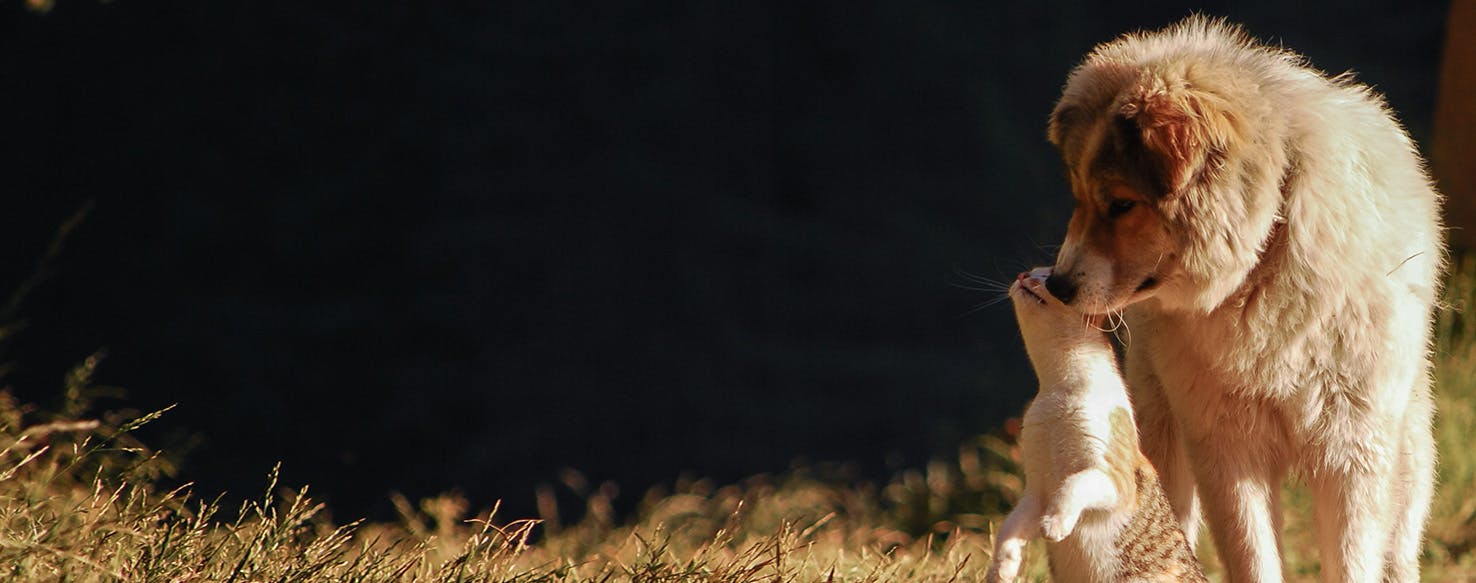- Home
- The Daily Wag!
- Behavior
- Why Do Dogs Play With Cats
Why Do Dogs Play With Cats

Common
Normal
Introduction
So many canine enthusiasts out there also happen to be cat enthusiasts. Because of this, a lot of those multi-animal owners will happen across the interactions between their dogs and cats. While this can sometimes contain a lot of less than positive behavior, many dogs and cats will engage in friendly play. So what are the risks when allowing this behavior? Is this something you should be encouraging on a regular basis, or perhaps something a little more menacing? Can dogs and cats truly transcend the stereotype and just get along? Below are some of the more popular opinions on this adorable behavior.
The Root of the Behavior
One of the really common explanations for play between cats and dogs is that it almost acts as a mechanism for translation. Dogs and cats both entertain a complex series of behaviors intended for communication, but they do not match up between their species. So in a household where both animals are trying to keep the peace while respecting each other's boundaries, they will 'mess around.' This behavior is especially prevalent if you get both animals when they are young. Kittens and puppies are both likely to engage in play anyways, so the 'warming up' process tends to be quicker and a little more natural.
Another interesting concept that has been popularized in recent years is that cats and dogs have developed so-called 'opposing scents' over the generations. Their differing odors literally drive the other species a little crazy. If your dog tends to be running around the house a little more, do not jump to immediate concern. It is entirely possible that the new scents are driving him more than a little mad, albeit temporarily. Dogs and cats both have a hypersensitive sense of smell, and this can most definitely affect their behavior.
Dogs and cats could also be engaging in play to show dominance. This is the one avenue in which play can turn negative. This tends to be on a case by case basis, and should not discourage you from letting your animals interact. In fact, a study done by a university in Israel in 2007 noted that almost 70% of all mixed-species households interact in a positive way. If you do note negative behaviors beginning to form when your cat and dog interact, you should be sure to intervene. A great way to do this is to consult with your local veterinarian about possible training programs.
Need advice about your pet's health?
Get answers fast from a veterinary professional 24/7 in the Wag! App.
Get Vet ChatEncouraging the Behavior
So what about when you really just can't tell the difference between play and fighting with your cat and dog? Luckily there are some really easy warning signs that you can learn to observe. This should luckily help you keep your cat and dog in harmony. The first behavior is if one pet or the other is frequently running away or hiding. Hiding is a really classic symptom of fear in either animal and can really disrupt a household. Running away can oftentimes be playful, so it's important to see both behaviors together before getting too concerned.
Biting is another part of the play that can be misconstrued as negative. This is sometimes true, but again the signs are the key here. Make sure that if biting is happening during play that there aren't any yelps or screams that occur. For dogs specifically, this is not a normal part of friendly play interactions. Cats on the other hand tend to play silently regardless of if it has become negative in nature. While a lot of owners assume that hissing is a clear cut sign that the cat wants to be alone, it's sometimes an inadvertent reaction to new stimuli. Keep a close watch if you cat is confusing you with his or her behavior.
Other Solutions and Considerations
If you're not really enjoying the interactions that occur between your cat and dog, the options depend more so on the environment you're proving them. If you live on a farm, perhaps there's the area for the dog to live outside in a closed off kennel area? Maybe it's possible to isolate the cat to an individual floor of your home. One of the simplest ways to avoid interactions is to physically deny them any chance to interact in the first place. A great alternative is to engage in training. This is something that is often found locally. If you're having trouble finding a proper program for your specific problem, usually your regular veterinary practitioner has the scoop on where to find someone respectable.
Conclusion
It seems pretty obvious here that in most cases it is alright to let your cats and dogs play together but you should keep your eyes peeled for any sort of negative behavior. This would include strong biting, cowering, and hiding behaviors primarily. But if your animals get along, enjoy the ride. And apparently in your house it's wise to bring an umbrella, as it's probably raining cats and dogs!
Written by a Pug lover Shane Langenfeld
Veterinary reviewed by:
Published: 03/09/2018, edited: 01/30/2020
More articles by Shane Langenfeld
